When comparing Bitcoin IRAs to traditional IRAs, you’ll find key differences in structure and asset class. Bitcoin IRAs focus on cryptocurrencies, offering direct ownership, while traditional IRAs primarily invest in stocks and bonds. Tax treatments also vary; traditional IRAs might provide tax-deductible contributions, whereas Bitcoin IRAs have no income limits. Plus, fees tend to be higher with Bitcoin IRAs. To really understand their impact on your portfolio, you’ll want to explore more details.
Key Takeaways
- Bitcoin IRAs enable direct ownership of cryptocurrencies, while Traditional IRAs focus on stocks, bonds, and limited exposure to crypto through ETFs.
- Specialized custodians are required for Bitcoin IRAs, whereas Traditional IRAs typically utilize mainstream financial institutions.
- Contributions to both IRAs are capped at $7,000 annually, but Bitcoin IRAs have no income limits for contributions.
- Bitcoin IRAs do not have required minimum distributions (RMDs), unlike Traditional IRAs which mandate withdrawals starting at age 72.
- Fees for Bitcoin IRAs are generally higher due to custodial and trading costs, compared to lower fees associated with Traditional IRAs.
Investment Structure and Asset Class

When considering retirement investment options, you’ll find a significant difference between a Bitcoin IRA and a Traditional IRA regarding asset structure and class. A Bitcoin IRA primarily holds cryptocurrencies, allowing you direct ownership of Bitcoin or other approved digital assets. In contrast, a Traditional IRA focuses on conventional asset classes like stocks, bonds, and mutual funds, with limited crypto exposure through ETFs. With a Bitcoin IRA, you get direct access to the crypto market, while a Traditional IRA limits your interaction to crypto-backed funds. Additionally, Bitcoin IRAs require specialized custodians for asset management, whereas Traditional IRAs typically use mainstream financial institutions. Understanding these distinctions helps you make informed decisions tailored to your retirement goals.
Tax Treatment Comparison
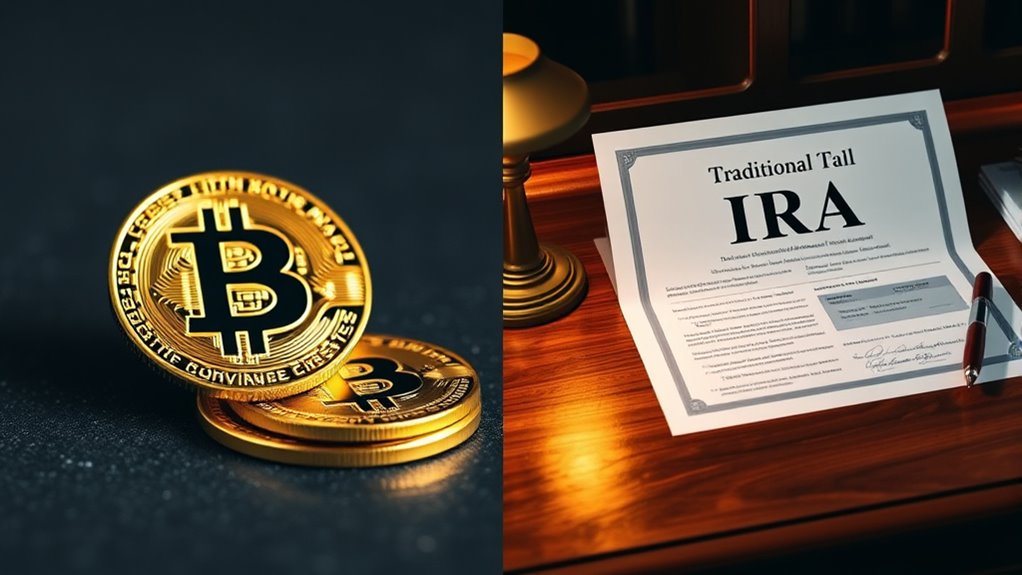
When comparing tax treatment between Bitcoin IRAs and traditional IRAs, you’ll notice distinct implications for contributions and withdrawals. With a traditional IRA, your contributions might be tax-deductible, while crypto IRAs offer tax deferral on gains until withdrawal. Understanding these nuances can help you make informed decisions about your retirement savings strategy. Additionally, it’s crucial to consider seasonal recommendations for your investment strategy, as market conditions can significantly impact your returns.
Contribution Tax Implications
While both Bitcoin IRAs and Traditional IRAs offer distinct tax advantages, understanding their contribution tax implications is crucial for effective retirement planning. Here’s a quick breakdown:
- Traditional IRA: You might get a tax deduction on contributions, reducing your taxable income for the year.
- Roth IRA: Contributions are made after-tax, but withdrawals, including gains, are tax-free in retirement.
- Bitcoin IRA (Traditional): Contributions are tax-deferred, with taxes applied at withdrawal, similar to a standard Traditional IRA.
- Bitcoin IRA (Roth): Like the Roth IRA, contributions are after-tax, and qualified withdrawals are tax-free, offering a unique advantage for crypto investors. Additionally, understanding color accuracy can improve the overall visual experience of your home cinema, paralleling the importance of financial clarity in retirement planning.
Withdrawal Tax Consequences
Understanding the tax implications of withdrawals is just as important as knowing the rules for contributions. When you withdraw from a Traditional IRA, you’ll pay ordinary income taxes on the entire distribution, including any gains. If you’re under age 59½, expect a 10% penalty on top of that unless you qualify for an exception.
In contrast, with a Bitcoin IRA, tax treatment mirrors that of a Traditional IRA. You’ll owe ordinary income tax on withdrawals, and early withdrawals trigger the same 10% penalty. If you opt for a Roth IRA, however, your qualified withdrawals are tax-free, allowing you to enjoy your gains without further tax implications. Knowing these differences can considerably impact your retirement strategy. Additionally, understanding the global implications of intelligence operations can provide insights into how financial systems are influenced by external factors.
Tax Deferral Benefits
Tax deferral is a significant advantage of both Traditional and Bitcoin IRAs, allowing your investments to grow without immediate tax consequences. Here’s how tax deferral benefits you in each type:
- Traditional IRA: Contributions may be tax-deductible, letting you reduce your taxable income for the year.
- Bitcoin IRA: Gains on your crypto investments aren’t taxed until you withdraw, preserving your capital for growth.
- Roth IRA: Contributions are made post-tax, but qualified withdrawals are tax-free, providing long-term tax savings.
- Crypto Roth IRA: Similar to the Roth, you enjoy tax-free withdrawals on gains, combining crypto’s potential with tax benefits. Additionally, self-directed IRAs allow for a diverse range of investment options, including cryptocurrency, enhancing your overall portfolio growth.
Contribution Limits and Rules
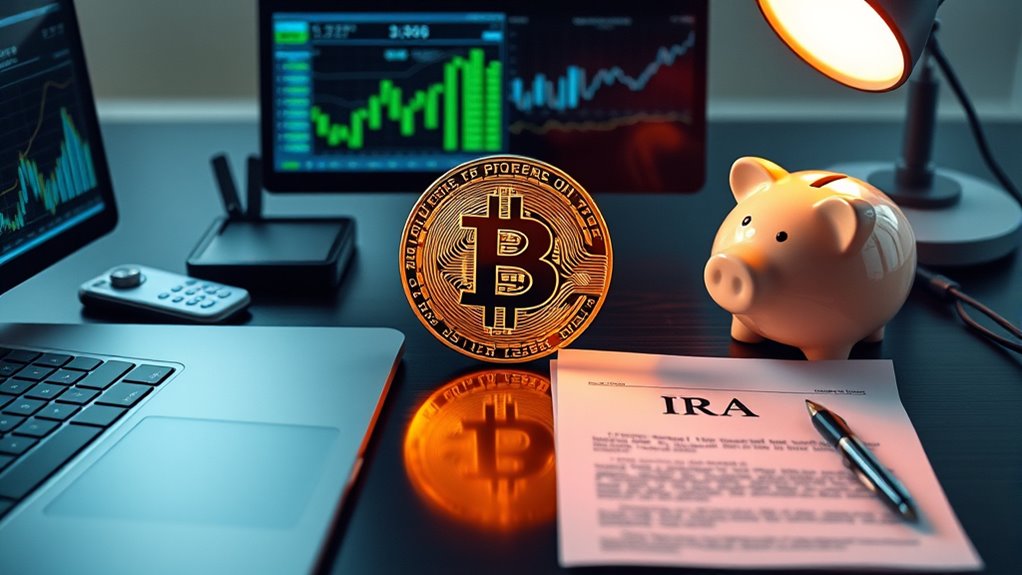
Both Bitcoin IRAs and Traditional IRAs share the same annual contribution limit of $7,000 for 2025, with an additional $1,000 catch-up contribution allowed for those aged 50 or older. You can make contributions to both types of accounts, but keep in mind that there are income limits that may affect your ability to contribute to a Roth IRA. Additionally, both account types have rules regarding prohibited transactions; you can’t use your holdings for personal benefit or as collateral. While Traditional IRAs require you to take required minimum distributions starting at age 73, Bitcoin IRAs don’t have this requirement. Familiarizing yourself with these limits and rules can help you plan effectively for your retirement. It’s essential to understand the rules regarding prohibited transactions to avoid penalties and ensure compliance with IRS regulations.
Early Withdrawal Penalties
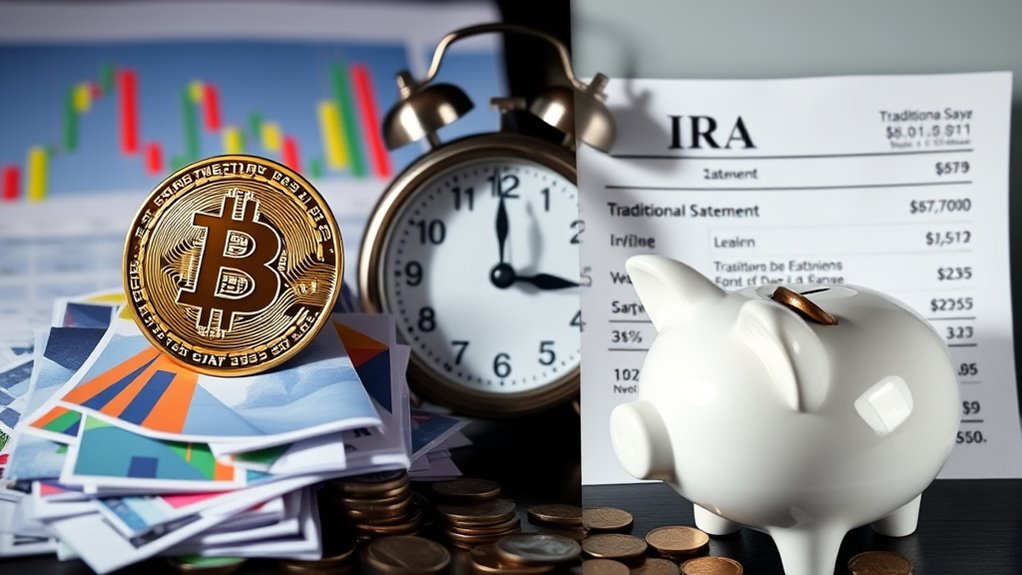
If you withdraw funds from your Bitcoin IRA or Traditional IRA before reaching age 59½, you’ll face a 10% penalty in addition to regular income taxes on the withdrawal. This penalty can substantially impact your retirement savings, so it’s vital to understand the rules. Here are some key points to bear in mind:
- Penalty Amount: A flat 10% penalty on the amount withdrawn.
- Tax Implications: Withdrawals are subject to regular income tax rates.
- Exceptions: Certain circumstances may allow penalty-free withdrawals, like disability or substantial medical expenses.
- Long-Term Impact: Early withdrawals can derail your retirement goals by reducing your investment growth potential.
Being aware of these penalties helps you make informed decisions about your retirement funds.
Required Minimum Distributions (RMDs)
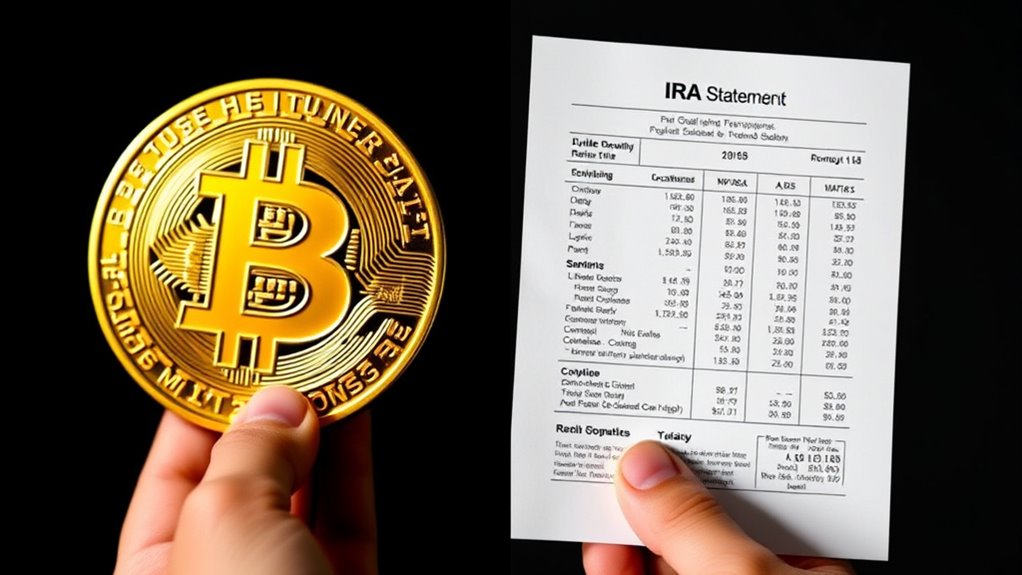
As you approach retirement, understanding Required Minimum Distributions (RMDs) becomes vital for managing your IRA effectively. If you hold a Traditional IRA, you must start taking RMDs by age 73. This means you’ll need to withdraw a certain amount each year, calculated based on your account balance and life expectancy. Failing to take RMDs can result in hefty penalties—up to 50% of the required amount. In contrast, Roth IRAs don’t require RMDs during your lifetime, allowing your investments to grow tax-free for longer. If you choose a Bitcoin IRA that’s structured as a Traditional IRA, the same RMD rules apply, making it essential to plan your withdrawals wisely to avoid penalties and manage your retirement funds effectively. Additionally, understanding how cultural narratives through film can impact investment decisions may provide valuable insights as you navigate your retirement planning.
Risk and Volatility Factors

Understanding RMDs is just one part of managing your retirement portfolio; you also need to contemplate the risks and volatility associated with your investments. Investing in a Bitcoin IRA brings unique challenges:
Managing retirement portfolios involves understanding RMDs and the unique risks of investing in a Bitcoin IRA.
- Price Fluctuations: Cryptocurrencies can experience extreme price swings, leading to potential gains or losses.
- Market Liquidity: Crypto trades 24/7, offering flexibility, but can also lead to rapid market changes.
- Lack of Protections: Unlike traditional assets, crypto holdings don’t have federal insurance, increasing risk exposure.
- Diversification Concerns: While adding crypto may reduce correlation with traditional assets, it also heightens overall portfolio risk.
Additionally, understanding custom exhaust systems for performance vehicles can provide insights into how specialized investments might enhance overall portfolio performance. Balancing these factors is essential to achieving a stable and successful retirement strategy.
Fees and Costs Analysis
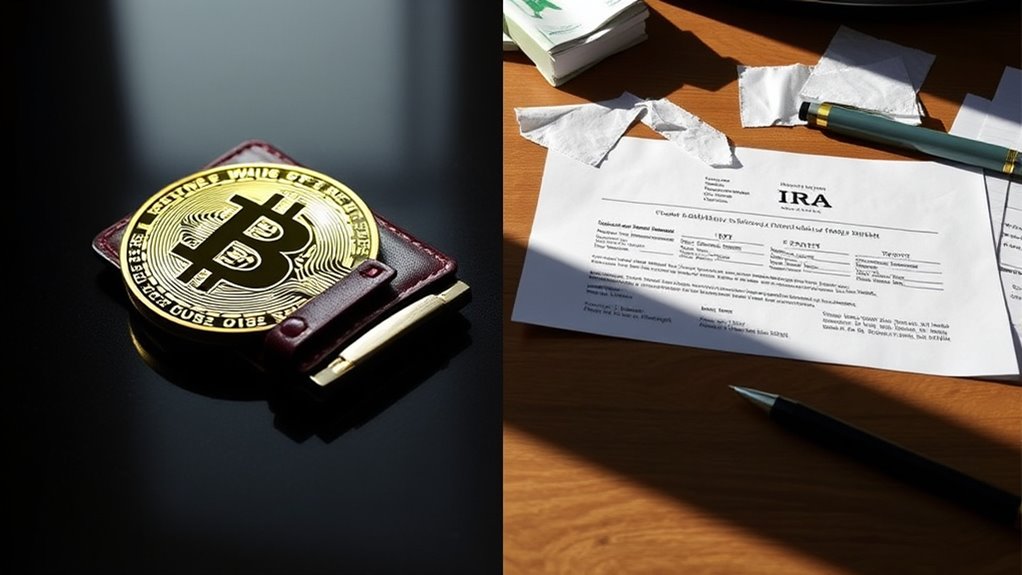
When evaluating a Bitcoin IRA versus a Traditional IRA, it’s essential to take into account the associated fees and costs, as these can considerably impact your investment returns. Bitcoin IRAs typically have higher fees due to specialized custodians, trading costs, and storage expenses. In contrast, Traditional IRAs often feature lower fees, especially when investing in low-cost index funds or ETFs. Here’s a quick comparison of the fees involved:
| IRA Type | Typical Fees | Additional Costs |
|---|---|---|
| Bitcoin IRA | Higher custodial fees | Transaction/storage fees |
| Traditional IRA | Lower fund management | Possible account fees |
| ETF Option | Standard expense ratios | No direct crypto fees |
Understanding these costs can help you make a more informed decision about your retirement investment strategy. Additionally, be aware that high fees associated with Bitcoin IRAs can significantly impact profit margins.
Market Trends and Accessibility

While the landscape of retirement investing evolves, market trends indicate a growing acceptance of cryptocurrencies within retirement portfolios. As you consider your options, keep these key factors in mind:
- Institutional Adoption: Major firms are launching crypto ETFs for traditional IRAs, showcasing increasing market confidence.
- Regulatory Clarity: A supportive regulatory environment is emerging, paving the way for more crypto-friendly policies.
- Market Performance: Bitcoin’s surge to all-time highs in late 2024 has sparked heightened interest in crypto IRAs.
- Accessibility: Setting up a crypto IRA requires a self-directed approach, while traditional IRAs remain easily accessible through various financial institutions.
These trends highlight the evolving landscape, offering you more avenues to diversify your retirement investments. Furthermore, AI-driven diagnostics are revolutionizing how financial institutions assess risk, which may influence investment strategies in the future.
Custodianship and Security
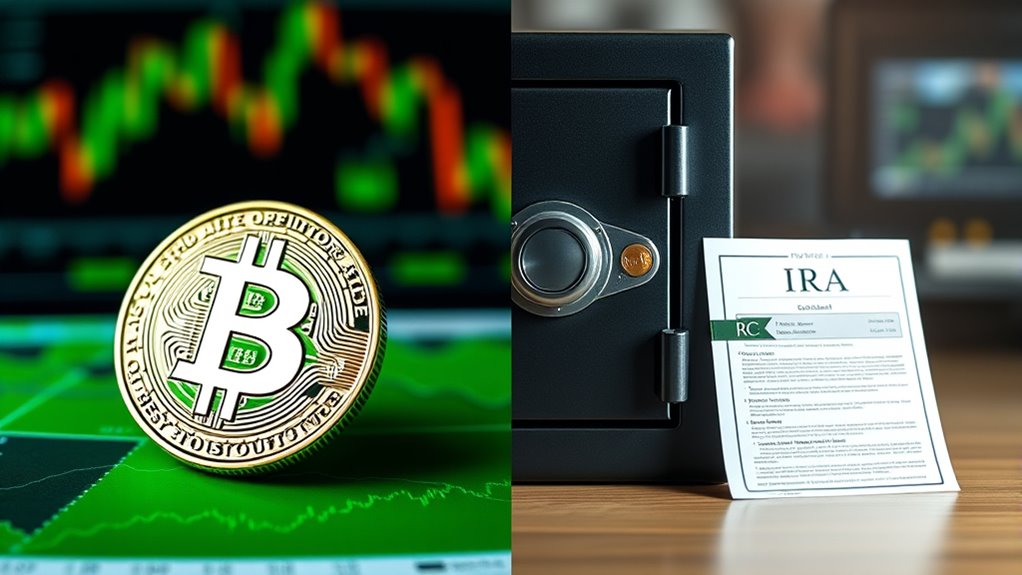
When you’re considering a Bitcoin IRA, you need to work with specialized custodians who understand cryptocurrency. This differs greatly from traditional IRAs, which rely on mainstream financial institutions for asset management. Understanding these security measures is essential for protecting your investments in both types of accounts. Additionally, many dog owners find that choosing a name for their pet can reflect their financial values, such as preppy dog names that convey a sense of style and sophistication.
Specialized Custodians Required
As you consider a Bitcoin IRA, understanding that these accounts require specialized custodians to manage your cryptocurrency holdings is essential. Unlike traditional IRAs, which can be managed by mainstream financial institutions, Bitcoin IRAs need custodians who are well-versed in the intricacies of digital assets. Here are four key roles they play:
- Secure Storage: They employ advanced security measures to protect your private keys and digital assets.
- Transaction Handling: Custodians facilitate buying, selling, and transferring cryptocurrencies on your behalf.
- Regulatory Compliance: They ensure all transactions comply with IRS regulations and guidelines.
- Tax Reporting: Custodians provide necessary documentation for tax purposes, simplifying your annual filings.
Choosing the right custodian is essential for the safety and management of your Bitcoin IRA.
Security Measures Differ Significantly
Security measures for Bitcoin IRAs and traditional IRAs differ markedly, impacting how you safeguard your investments. With a Bitcoin IRA, you’ll rely on specialized custodians who focus on cryptocurrency security, often incorporating advanced measures like cold storage and multi-signature wallets. These custodians protect your digital assets from hacks and theft, but they also require you to trust their security protocols.
In contrast, traditional IRAs generally use mainstream financial institutions that provide more standardized security measures, such as FDIC insurance for cash holdings. While these institutions might lack the same level of crypto-specific protection, they offer a level of consumer protection you might find reassuring. Ultimately, understanding these differences is essential in choosing the right IRA for your needs.
Diversification and Portfolio Impact

While traditional asset classes offer stability, incorporating a Bitcoin IRA into your retirement portfolio can enhance diversification. By adding cryptocurrencies, you can potentially reduce the overall risk of your investments. Here are four key benefits of diversification with a Bitcoin IRA:
- Reduced Correlation: Crypto often behaves differently than stocks and bonds, providing a buffer during market downturns.
- Potential for Higher Returns: Cryptocurrencies can yield substantial gains, boosting your portfolio’s growth.
- Inflation Hedge: Bitcoin’s limited supply may protect against inflation, unlike traditional fiat currencies.
- Increased Flexibility: Crypto markets operate 24/7, allowing you to react swiftly to market changes.
Incorporating a Bitcoin IRA can create a more resilient retirement strategy tailored to your financial goals.
Frequently Asked Questions
Can I Transfer My Existing IRA to a Bitcoin IRA?
Yes, you can transfer your existing IRA to a Bitcoin IRA. You’ll need to initiate a rollover process with your current IRA provider and choose a Bitcoin IRA custodian. Make sure to follow the IRS guidelines to avoid taxes or penalties. Once the transfer’s complete, you’ll have the ability to invest directly in cryptocurrencies within your new account. Just guarantee you understand the risks and fees associated with Bitcoin IRAs before making the switch.
What Happens if My Bitcoin IRA Loses Value?
If your Bitcoin IRA loses value, you’ll face a decline in your retirement savings. For instance, imagine you invested $10,000 in a Bitcoin IRA, and the value drops to $5,000. While this loss can be disheartening, it’s essential to remember that IRAs are long-term investments. You could see recovery over time, but be prepared for volatility. Consider adjusting your strategy or diversifying your portfolio to mitigate future risks.
How Do I Choose a Bitcoin IRA Custodian?
To choose a Bitcoin IRA custodian, start by researching their reputation and regulatory compliance. Look for custodians that specialize in cryptocurrency and have experience in the industry. Compare fees, services, and security features. Verify they offer a user-friendly platform for managing your assets. Check if they provide educational resources to help you understand the process. Finally, read customer reviews to gauge satisfaction and reliability before making your decision.
Are There Tax Implications for Transferring to a Bitcoin IRA?
Yes, there are tax implications for transferring to a Bitcoin IRA. If you’re rolling over funds from a traditional IRA, you won’t face immediate taxes, as long as you follow IRS guidelines. However, if you withdraw funds directly to transfer, you might incur taxes and penalties. Additionally, if you decide to convert to a Roth Bitcoin IRA, you’ll owe taxes on the converted amount. Always consult a tax professional for tailored advice.
Can I Hold Non-Crypto Assets in a Bitcoin IRA?
No, you can’t hold non-crypto assets in a Bitcoin IRA. This type of account is specifically designed for cryptocurrency investments, allowing direct ownership of Bitcoin and other approved digital assets. If you want to include traditional assets like stocks or bonds, you’ll need a different type of IRA, such as a traditional or self-directed IRA. Be sure to choose the right account structure to meet your investment goals effectively.
Conclusion
In conclusion, understanding the key differences between Bitcoin and traditional IRAs can help you make informed decisions about your investments. While Bitcoin offers unique opportunities for growth, traditional IRAs provide stability and tax advantages. Which option aligns better with your financial goals? Ultimately, it is crucial to weigh the benefits and risks of each investment type, ensuring that your portfolio reflects your personal values and aspirations while preparing for a secure financial future.









